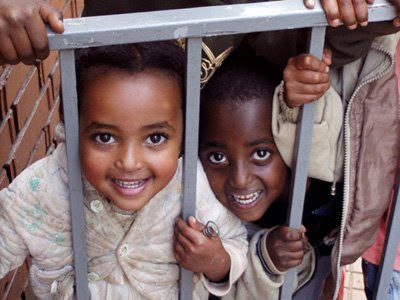Broadneck teacher adopts Ethiopian sisters
By ELISABETH HULETTE, Staff Writer
www.hometownannapolis.com/
Published February 18, 2008 For the past few months, the Stimely family's four daughters have been throwing nightly dance parties in their living room to the tunes of Disney's wildly popular "High School Musical."
It'd be a nightly scene like any other, except that two of the girls are brand new to both American people and pop culture. The Stimelys adopted Masene, 5, and Safiya, 3, from Ethiopia in November. Their mother, Carol Bittner, said the dance parties have brought the girls closer to their new American sisters, Ruth, 7, and Lillian, 3.
"It feels good to have two new people in the family," Ruth said. "We just play and have fun."
The Stimelys are among a growing number of people adopting from Ethiopia. China and Russia have been the major hubs for adoption, but Ethiopia's star is rising, Ms. Bittner said.
A combination of the country's relatively easy adoption paperwork and large number of children orphaned by the AIDS epidemic has drawn an increasing number of adoption agencies over the past few years, said Merrily Ripley, director of Adoption Advocates International, the agency that helped the Stimelys adopt Masene and Safiya.
About 3,500 Ethiopian children have been adopted by American families since 1990, and of those, about 1,250 children were adopted in 2007 alone, said Hermela Kebede, director of the Ethiopian Community Center in Washington. Government officials have estimated that 4,000 will be adopted in 2008, she said.
"That's how much it's growing," Ms. Kebede said.
Wait times for adopting Ethiopian children are longer than they've ever been, said Ms. Ripley, as agencies realize that Ethiopia's clear adoption procedures make it a good country for international adoption.
Also, because of new drugs that reduce the risk of spreading HIV, American families can now adopt HIV-positive children, Ms. Ripley said. Adoption Advocates placed about 30 HIV-positive children from Ethiopia last year, she said.
"That's something we never thought we'd be able to do 5 to 10 years ago," she said.
American families are aware that HIV, malaria, yellow fever and poverty have left many children orphaned.
"I think because they're aware of the need there, the orphans, a lot of folks are motivated by wanting to adopt a child," Ms. Ripley said.
That was one reason why the Stimelys decided to adopt from Ethiopia.
Ross Stimely, a teacher at Broadneck High School, and Ms. Bittner, who is an attorney for the federal court in Baltimore, had talked about adopting for years. It would be a way to make a difference and also grow their family, Mr. Stimely said.
They decided to work through Adoption Advocates because unlike agencies that focus on babies, Adoption Advocates works with older children and tries to keep siblings together, Ms. Bittner said. The agency has placed as many as five siblings together, Ms. Ripley said.
They applied and in May were told the agency had found two little girls who needed a family. But summer is the rainy season in east Africa, and the Stimelys had to wait until November to make the trip.
They passed the months by writing to Masene and Safiya, sending them photos of their new house, their new sisters. The trip they finally took in November with Ruth and Lillian was the furthest they had ever traveled, Mr. Stimely said.
He and Ms. Bittner met their new daughters on Nov. 19 - a date that also happened to be their 13th wedding anniversary.
Masene and Safiya are from a rural part of southern Ethiopia, where people raise sheep and goats and have neither electricity nor running water, Ms. Bittner said. The girls were apprehensive when they first arrived in the United States.
To help them adjust, the Stimelys have been cooking traditional Ethiopian food, like potato stew and injera, a sort of pancake that's a staple of the Ethiopian diet, Mr. Stimely said. Ruth and Lillian have been taking Ethiopian food to school in their packed lunches. And they're trying to learn Amharic, the regional Ethiopian language.
Lillian and Ruth have already picked up some Amharic, he said, just as Masene and Safiya have picked up the words to High School Musical. Lillian, at 3 years old, has already forgotten what it's like not to have adopted sisters, Ms. Bittner said.
"For her, it's completely normal," Ms. Bittner said. "Like, doesn't everyone have a sister from Ethiopia?"
The Stimelys hope their story will inspire more people to adopt one of the many Ethiopian children who need families. If their family can do it, anyone can, Ms. Bittner said.
"We are completely normal, regular people, except we saw a problem and acted on it," she said. "We're just raising our kids. It's just life, and you can do it and it can be great."





